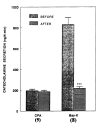Influence of pentobarbital-Na on stimulation-evoked catecholamine secretion in the perfused rat adrenal gland
- PMID: 9439151
- PMCID: PMC4531992
- DOI: 10.3904/kjim.1997.12.2.163
Influence of pentobarbital-Na on stimulation-evoked catecholamine secretion in the perfused rat adrenal gland
Abstract
Objectives: The present study was attempted to investigate the effects of pentobarbital-Na, one of the barbiturates which are known to depress excitatory synaptic transmission in the central nervous system at concentrations similar to those required for the induction and maintenance of anesthesia, on catecholamines (CA) secretion evoked by cholinergic stimulation and membrane-depolarization from the isolated perfused rat adrenal gland, and to clarify the mechanism of its action.
Methods: Mature male Sprague-Dawley rats were anesthetized with thiopenal-Na (40 mg/kg, s.c.). The adrenal gland was isolated by the methods of Wakade. A cannula used for perfusion of the adrenal gland was inserted into the distal end of the renal vein. The adrenal gland was carefully removed from the animal and placed on a platform of a leucite chamber.
Results: The perfusion of pentobarbital-Na(30-300 uM) into an adrenal vein for 20 min produced relatively dose-dependent inhibition in CA secretion evoked by ACh(5.32 mM), DMPP(100 uM for 1 min), McN-A-343(200 uM for 2 min), Bay-K-8644(10 uM) and high potassium(56 mM), while it did not affect the CA secretion of cyclopiazonic acid(10 uM). Also, in the presence of thiopental-Na (100 uM), CA secretory responses evoked by ACh, DMPP, McN-A-343 and high K+ were markedly depressed. Moreover, in adrenal glands preloaded with ketamine(100 uM for 20 min), which is known to be a dissociative anesthetic, CA secretion evoked by ACh, DMPP, McN-A-343 and high K+ were significantly attenuated.
Conclusion: Taken together, these experimental results suggest that pentobarbital-Na depresses CA release evoked by both cholinergic stimulation and membrane-depolarization from the isolated rat adrenal medulla and that this inhibitory activity may be due to the result of the direct inhibition of Ca++ influx into the chromaffin cells without any effect on the calcium mobilization from the intracellular store.
Figures







Similar articles
-
Influence of 17- alpha-estradiol on catecholamine secretion from the perfused rat adrenal gland.Korean J Intern Med. 1996 Jan;11(1):25-39. doi: 10.3904/kjim.1996.11.1.25. Korean J Intern Med. 1996. PMID: 8882474 Free PMC article.
-
Inhibitory mechanism of pinacidil on catecholamine secretion from the rat perfused adrenal gland evoked by cholinergic stimulation and membrane depolarization.J Auton Pharmacol. 2000 Apr;20(2):123-32. doi: 10.1046/j.1365-2680.2000.00171.x. J Auton Pharmacol. 2000. PMID: 11095550
-
Inhibitory mechanism of bromocriptine on catecholamine release evoked by cholinergic stimulation and membrane depolarization from the rat adrenal medulla.Arch Pharm Res. 2002 Aug;25(4):511-21. doi: 10.1007/BF02976611. Arch Pharm Res. 2002. PMID: 12214865
-
Arecoline inhibits catecholamine release from perfused rat adrenal gland.Acta Pharmacol Sin. 2006 Jan;27(1):71-9. doi: 10.1111/j.1745-7254.2006.00233.x. Acta Pharmacol Sin. 2006. PMID: 16364213
-
Influence of lobeline on catecholamine release from the isolated perfused rat adrenal gland.Auton Neurosci. 2004 Jan 30;110(1):27-35. doi: 10.1016/j.autneu.2003.10.001. Auton Neurosci. 2004. PMID: 14766322
Cited by
-
Intravenously administered hypocretin-1 alters brain amino acid release: an in vivo microdialysis study in rats.J Physiol. 2003 Apr 15;548(Pt 2):557-62. doi: 10.1113/jphysiol.2002.038729. Epub 2003 Mar 7. J Physiol. 2003. PMID: 12626669 Free PMC article.
References
-
- Cox RH, Bagshaw RJ. Influence of anesthesia on the response to carotid hypotension in dogs. Am J Physiol. 1979;237:H424–432. - PubMed
-
- Hosomi H, Sagawa K. Effect of pentobarbital anesthesia on hypotension after 10 % hemorrhage in the dog. Am J Physiol. 1979;236:H607–612. - PubMed
-
- Manders WT, Vatner SF. Effects of sodium pentobarbital anesthesia on left ventricular function and distribution of cardiac output in dogs, with particular reference to the mechanism for tachycardia. Circ Res. 1976;39:512–517. - PubMed
-
- Vanter SF, Braunwald E. Cardiovascular control mechanisms in the conscious state. N Engl J Med. 1975;293:970–976. - PubMed
MeSH terms
Substances
LinkOut - more resources
Full Text Sources
